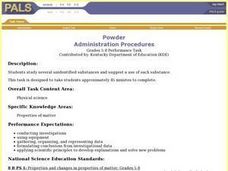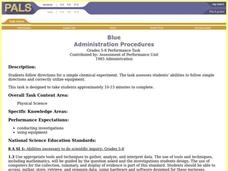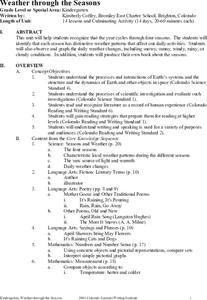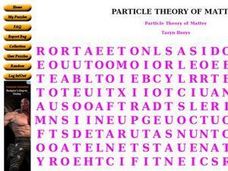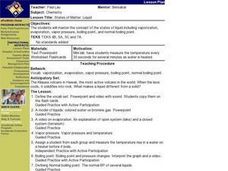Curated OER
Unknown Element Project
High schoolers work with a partner to determine the identity of an unknown element based on given descriptions. Groups use classroom textbooks, encyclopedias, and science internet sites to identify their unknown element then write a...
Curated OER
Heating of Water: Water Vapour
Seventh graders read the directions printed on their worksheet and follow them carefully. They set up a beaker with a tripod and Bunsen burner under it. They record the temperature of water every 30 seconds. Students graph the data and...
Curated OER
Powder
Students investigate several unidentified substances and suggest a use of each substance. They can explain that a substance has characteristic properties, such as density, a boiling point, and solubility, all of which are independent of...
Curated OER
Blue
Students follow directions for a simple chemical experiment. They use the appropriate tools and techniques to gather, analyze, and interpret data. Students identify a substance that has characteristic properties, such as density, a...
Curated OER
Solids And Liquids
Students discuss the properties of solids and liquids. They complete a worksheet to show the boiling and melting points of several substances and consider if these factors affect how humans use materials.
Curated OER
Weather through the Seasons
Students examine the year's cycles by observing the four seasons, their distinctive weather patterns that affect our activities and the weather changes that each brings. The fourteen lessons of this unit offer a good opportunity for the...
Curated OER
Intermolecular Forces
For this compounds worksheet, students identify the main intermolecular force in the given compounds and explain the differences between dipole-dipole forces and hydrogen bonds. This worksheet has 5 short answer questions.
Curated OER
Compounds and Molecules
In this compounds worksheet, students compare separating elements of a compound and substances in a mixture. Students review melting and boiling point. This worksheet has 1 fill in the blank and 5 short answer questions.
Curated OER
Colligative Properties Worksheet
In this solutions worksheet, students determine the boiling points and melting points of solutions. Students calculate the effective molality of a solute. This worksheet has five problems to solve.
Curated OER
Solutions Quiz Review Sheet
For this solutions worksheet, students use a phase diagram to determine the boiling point and molality of the solution. Students determine the electrical conductivity of a saturated solution. This worksheet has nine problems to solve.
Curated OER
Wet Dry Ice Lab
In this wet dry ice worksheet, learners read the information about dry ice and phase change. Students perform an experiment in which they observe phase changes of ice. Learners answer analysis questions as it relates to the phase change...
Curated OER
Evidence for Hydrogen Bonds
In this hydrogen bonds worksheet, students use three data tables showing the boiling points for various compounds containing hydrogen to create three graphs for comparison.
Curated OER
Chemistry Wk 2
In this chemistry activity, students calculate the freezing point of a given solution. Students calculate the final temperature and state of the water in a given problem. Students solve several problems provided.
Curated OER
Particle Theory of Matter
In this science word search worksheet, students identify and locate words in a puzzle that relate to particle theory of matter. There are 24 words to locate in the puzzle and spell correctly.
Curated OER
States of Matter: Liquid
Students work in a mini lab where they measure the temperature every 30 seconds for several minutes as water is heated. They are asked what makes liquid different from a solid. Students view a PowerPoint on the model of liquids,...
State University of New York
State University of New York: Boiling Points of Simple Organic Compounds
This simulation explores the effects of molecular structure on normal boiling points for a series of related organic compounds.
University of Waterloo (Canada)
The University of Waterloo: The Heating Curve
The heat of vaporization along with several other thermal properties are explained. Sample problems are given. Illustrations.




